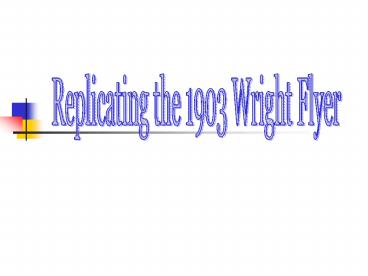Replicating the 1903 Wright Flyer - PowerPoint PPT Presentation
1 / 26
Title:
Replicating the 1903 Wright Flyer
Description:
Wing warping tested on 1899 kite. 1901 glider was a disappointment. Wind tunnel testing leads to 1902 glider. First powered flight, 1903. Problems in replication ... – PowerPoint PPT presentation
Number of Views:57
Avg rating:3.0/5.0
Title: Replicating the 1903 Wright Flyer
1
Replicating the 1903 Wright Flyer
2
Introduction
- Sir George Cayley
- Conventional configuration
- Otto Lilienthal
- Airfoil data, first pilot
- Alphonse Penaud
- Rubber powered models
- Octave Chanute
- Pratt truss
3
Wright Brothers
- Control centric approach
- Wing warping for roll control
- First wind tunnel tests
- Adverse yaw
- Canard for pitch control
4
The Wright approach
- Wing warping tested on 1899 kite
- 1901 glider was a disappointment
- Wind tunnel testing leads to 1902 glider
- First powered flight, 1903
5
Problems in replication
- Instability
- Pitch, CG behind NP
- Spiral mode, Anhedral
- Control
- Smaller tail volumes
- Constructional
- Practical limits due to scaling down
6
Strategy
7
Strategy
- Exploring a/c
- Literature study
- Proposed solutions
- Making gliders
- Material selection
- Practical limits on fabrication
- Implementation of control mechanisms
8
Propulsion
- Market survey for
- Contra-rotating pushers
- Belts, pulleys and shafts
- Engine
- Test the setup
9
Glider Specifications
- 112 scaled down model
- Wing Span 1.02 m
- Length 0.54m
- Canard area 6.3 of wing area, 0.0210 m2
- Rudder area 0.01 m2
- Weight 0.15 Kg
- Ballast weight 0.040 Kg
- Wing loading 0.11 kg/m2
10
Glider
11
Glider Experience
- Material selection
- Central carbon fibre box supporting
- Wing
- Canard and rudder
- Engine
- Landing gear
12
Central Box
13
Glider Experience
- Material selection
- Balsa wood used for
- Wing ribs
- Canard and rudder
- Vertical struts
14
Glider Experience
- Monokote for wing covering
- Slotted ribs for front spar
- Joints
- Strut-spar pin joints replicated
- Pins lashed to spars and struts
- Rigging with twine thread
15
View of joints
16
Glider Experience
- Controls
- Steel wire for wing warping
- Flexible joints in rear spar for wing warping
- Complete canard moved for pitch control
- (unlike original variable camber)
17
Weight estimation
- Controls part
- 4 servos Receiver Battery pack
Miscellaneous - 160gm 30gm 120gm 50gm
360 gm - Propulsion part
- Engine Mount Shafts, Belts, Pulleys Fuel
Misc 335gm 150gm 300gm 250gm 65gm
1100 gm - Landing gear
150gm - Structure part
- Carbon fiber composite Balsa Misc
- 450gm 300gm 250gm
1000gm - Total Maximum weight 3 kg
- Wing loading with this weight 0.338 kg/m2
18
Thrust and Power Estimation
- Max thrust required at min Cl/Cd 12 N
- Power required at this Cl/Cd is 120 W
- Engine of 250 W at 16000 rpm
- Two 10X6 props at 8000 rpm give 15 N thrust
- Thrust in lbs 2.83x10-12 x RPM2 x D4 x Cp x
(P/29.92) x (528/(460T))
19
Propulsion
- Electric motor
- Less weight
- No starting problems
- Ease of maintenance
- Large battery weight (Can be used as ballast)
- Lesser heating problems
20
Propulsion
- Wankel IC engine
- High power
- Less fuel weight
- Cooling problems ?
21
Propulsion
- Belt pulley system
- Propeller shaft mounting replicated
- Contra-rotating propellers ?
22
Side view transmission system
9.3 cm
4 cm
11 cm
6 cm
25 cm
23
Front View
23.5 cm
12 cm
5 cm
39.4 cm
24
Unsolved problems
- Roll-yaw coupling ?
- Asymmetric yawing moment ?
- Pitch SAS using rate gyro?
- Tail and canard volumes ?
- Anhedral ?
- Landing ?
- Twisted belt drive ?
25
Cost Estimate
26
Acknowledgements
- Prof. K. Sudhakar, IIT Bombay
- Dr. H. Arya, IIT Bombay































